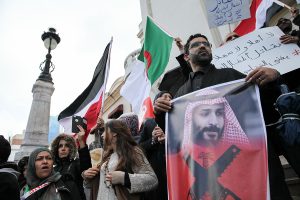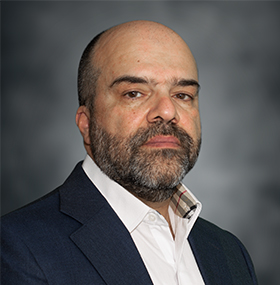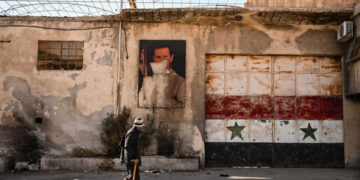Eric Goldstein is the former deputy director of Human Rights Watch's Middle East and North Africa division.
Israeli prison staff are torturing Palestinian inmates, beating and sexually abusing them, denying them adequate food and medical care, with sometimes fatal results, according to disturbing reports published in recent months by B'Tselem, Physicians for Human Rights–Israel, Human Rights Watch, UNRWA and others. In light of the horrors unfolding in the Gaza Strip since October 7, this may sound like a "dog bites man, tell-me-what-else-is-new" kind of headline. To me it is not, at least not entirely. Here's why.
One of my first assignments when I started working on Israel-Palestine for Human Rights Watch was to visit and investigate Israeli places of detention. The report I authored, published in 1991, concluded that Israel operated a penitentiary system where at least some rules were in place. Excluding the phase when a detainee was under interrogation—a critical caveat—physical violence by prison staff was uncommon and inmates received basic necessities, including an adequate diet, though conditions were austere and in some respects cruel. The interrogation phase, though, was something else entirely. It involved systematic torture and severe deprivation, as HRW documented in a separate report in 1994.
Mass incarceration has always been part of the apartheid system by which Israeli authorities subjugate Palestinians. But there was a boundary between how they treated, on the one hand, Palestinians under interrogation and how they treated those who were no longer under interrogation or who had been placed directly in administrative detention without passing through interrogation. For the latter, conditions were harsh and in some respects violated international law, especially at the notorious Ketziot camp run by the Israel Defense Forces in the southern Negev desert and at the so-called Russian Compound in Jerusalem, also known as al-Moscobiyeh.
Since October 7, when Hamas-led militants attacked southern Israel, killing some 1,200 people, the dividing line between the treatment of Palestinian prisoners during and after interrogation has been largely erased. It is another consequence of Israel's devastating war in Gaza.
When I visited Israeli prisons during the First Intifada, conditions for Palestinians who were not under interrogation were harsh but still governed by norms and parameters.
- Eric Goldstein
Last month, B'Tselem published a damning report on the conditions both in places of detention run by the IDF and in those run by the Israel Prison Service (IPS), housing both Palestinians from Gaza and the West Bank. Titled "Welcome to Hell: The Israeli Prison System as a Network of Torture Camps," the report, which was based on interviews with recently released inmates, describes "frequent acts of severe, arbitrary violence; sexual assault; humiliation and degradation; deliberate starvation; forced unhygienic conditions; sleep deprivation; prohibition on, and punitive measures for, religious worship; confiscation of all communal and personal belongings; and denial of adequate medical treatment." This treatment is not limited to interrogations. "Violence is an ever-present part of daily life: every time a prisoner enters or exits the cell, on rare visits to the infirmary, before and after court hearings, and even before being released," B'Tselem concluded.
"As opposed to the torture by the Shin Bet, which presumably had a security-minded purpose—to extract information—here it's solely to satisfy the darkest and sickest sadistic urges," Haaretz columnist Gideon Levy wrote of the report.
Although the decline in prison conditions accelerated after October 7, this story began before then. Since becoming minister of national security late in 2022, far-right politician Itamar Ben Gvir proudly issued directives to the IPS, which is under his authority, to "toughen" conditions for Palestinian security prisoners. The spike in the number of Palestinians taken into custody after October 7 may explain in part the overcrowding and harsh regime behind bars. But it cannot explain the systematically violent, abusive and often life-threatening conditions that prevail across both IPS prisons like Megiddo and IDF detention centers like Sde Teiman and Ofer. These amount to a policy carried out with near-total impunity.
Another bellwether change between the First Intifada and today is Israel's termination after October 7 of the program of regular visits by delegates of the International Committee of the Red Cross to Palestinian security prisoners in their places of detention. For decades, the ICRC visits, which included one-on-one confidential conversations, brought an element of protection to the prisoners, even if Israel denied Red Cross representatives access to persons under interrogation and even if the arrangement required the humanitarian organization to refrain from publicizing what it saw and heard. Since October 7, no independent group has been able to monitor Israeli places of detention. (In response to a petition by human rights groups filed in February, Israel's High Court of Justice on August 25 ordered the government to justify its ban on ICRC prisoner visits.)
One of the most notorious facilities is at Sde Teiman, a military base in the Negev that used to hold Palestinians from Gaza for initial screening but, since October 7, has taken in more than 4,000 men from Gaza, some for extended periods of detention. The torture of inmates before, during and after their interrogation has been widely reported on for months. In March, an unnamed doctor at a field hospital at the base decried in a letter to authorities the use of handcuffs so tight, including around prisoners' legs, that "just this week, two prisoners had their legs amputated due to handcuff injuries, which unfortunately is a routine event." Sde Teiman is the facility where, in July, nine Israeli soldiers were suspected of severely injuring a Palestinian inmate by sodomizing him with an object. When army police arrived to arrest the suspects, a crowd of Israelis, including members of the Knesset, stormed the base in protest at this rare step by authorities to hold soldiers accountable for abuse.
B'Tselem reports that an astonishing 60 Palestinians have died in Israeli custody since October 7. The IDF prosecutor-general, who is tasked with investigating such cases, said that an unspecified number of these deaths involved Palestinians who succumbed to injuries that they had sustained before their detention. Even if this is true in some cases, ample documentation by B'Tselem, Haaretz and others in Israel show that many deaths followed mistreatment and medical neglect. The dead include at least two Gaza physicians, Adnan al-Bursh, the head of orthopedics at Shifa Hospital, and Iyad Rantisi, who headed a women's health center. Neither doctor is thought to have sustained any injuries before Israeli forces detained them.
Mass incarceration has always been part of the apartheid system by which Israeli authorities subjugate Palestinians.
- Eric Goldstein
When I visited Israeli prisons during the First Intifada, conditions for Palestinians who were not under interrogation were harsh but still governed by norms and parameters. While prison conditions had been deteriorating prior to October 7, after the events of that date, all restraints were off.
This trajectory is not limited to the treatment of Palestinians in custody. It applies also to the use of lethal force by IDF soldiers patrolling in the occupied territories. The first report I wrote for Human Rights Watch, in 1990, was about the unlawful killings of Palestinians by Israeli soldiers who were given overly permissive open-fire regulations in the West Bank and Gaza, and how the IDF investigated them. I don't want to suggest that there was much accountability even then for soldiers who killed Palestinians in violation of their open-fire orders. The IDF gave its men wide latitude. But in those days, between the little booklet summarizing the rules on opening fire that Israeli soldiers were instructed to carry in their pockets and the oral briefings that their commanders gave them, there was an awareness of the situations in which they were permitted to open fire.
In the years prior to October 7, the IDF's restraints on opening fire seemed to erode in practice, even if the Israeli government would not disclose what the current regulations were or whether they had changed. Fatal shootings of Palestinians in the West Bank had been increasing since 2021 compared to previous years, and then soared after October 7. As Haaretz reported in January 2023, since "December 2021, soldiers are allowed to shoot at Palestinians who are fleeing if they had previously thrown stones or Molotov cocktails." Such a rule would be looser than the official regulations on firing at fleeing suspects that were in effect during the First Intifada.
After October 7, the open-fire regulations, whatever they were worth previously, have also eroded further, especially for soldiers operating in the Gaza Strip. +972 Magazine reported in July, based on interviews with soldiers who had served in Gaza, that they are essentially given carte blanche to shoot as they please, especially at persons they see in IDF-declared no-go zones, without first trying to ascertain their status as civilian or combatant.
The research I did during First Intifada provides data points, if any more were needed, that in terms of prison conditions, as with the use of lethal force by Israeli security forces, it's a far grimmer picture today than back then.
Several Israeli human rights groups have petitioned the Israeli Supreme Court to order the closure of Sde Teiman. In response, the IDF told the court that conditions have improved as authorities reduced the number of detainees and implemented policy changes like restrictions on handcuffing. They said the conditions would improve further with the opening of a new wing this fall.
For Gideon Levy, recoiling at the B'Tselem report and the indifferent response to it by his fellow Israelis, "Sde Teiman also defines Israel, more than its other characteristics," as he wrote in Haaretz. "Israel is Sde Teiman, Sde Teiman is Israel." I would add that Gideon Levy also defines Israel, as do B'Tselem, Physicians for Human Rights–Israel and the many other courageous organizations that have persevered in suing the authorities over Sde Teiman, the army's open-fire orders and other human rights issues. Sadly, their voices are heard more loudly abroad than inside Israel, these days more than ever.

















![Security forces loyal to the interim Syrian government stand guard at a checkpoint previously held by supporters of deposed president Bashar al-Assad, in the town of Hmeimim, in the coastal province of Latakia, on March 11, 2025. Syria's new authorities announced on March 10, the end of an operation against loyalists of deposed president Bashar al-Assad, after a war monitor reported more than 1,000 civilians killed in the worst violence since his overthrow. The Syrian Observatory for Human Rights said the overwhelming majority of the 1,068 civilians killed since March 6, were members of the Alawite minority who were executed by the security forces or allied groups. (Photo by OMAR HAJ KADOUR / AFP) / “The erroneous mention[s] appearing in the metadata of this photo by OMAR HAJ KADOUR has been modified in AFP systems in the following manner: [Hmeimim] instead of [Ayn Shiqaq]. Please immediately remove the erroneous mention[s] from all your online services and delete it (them) from your servers. If you have been authorized by AFP to distribute it (them) to third parties, please ensure that the same actions are carried out by them. Failure to promptly comply with these instructions will entail liability on your part for any continued or post notification usage. Therefore we thank you very much for all your attention and prompt action. We are sorry for the inconvenience this notification may cause and remain at your disposal for any further information you may require.”](https://dawnmena.org/wp-content/uploads/2025/04/syria-22039885951-350x250.jpg)











![Security forces loyal to the interim Syrian government stand guard at a checkpoint previously held by supporters of deposed president Bashar al-Assad, in the town of Hmeimim, in the coastal province of Latakia, on March 11, 2025. Syria's new authorities announced on March 10, the end of an operation against loyalists of deposed president Bashar al-Assad, after a war monitor reported more than 1,000 civilians killed in the worst violence since his overthrow. The Syrian Observatory for Human Rights said the overwhelming majority of the 1,068 civilians killed since March 6, were members of the Alawite minority who were executed by the security forces or allied groups. (Photo by OMAR HAJ KADOUR / AFP) / “The erroneous mention[s] appearing in the metadata of this photo by OMAR HAJ KADOUR has been modified in AFP systems in the following manner: [Hmeimim] instead of [Ayn Shiqaq]. Please immediately remove the erroneous mention[s] from all your online services and delete it (them) from your servers. If you have been authorized by AFP to distribute it (them) to third parties, please ensure that the same actions are carried out by them. Failure to promptly comply with these instructions will entail liability on your part for any continued or post notification usage. Therefore we thank you very much for all your attention and prompt action. We are sorry for the inconvenience this notification may cause and remain at your disposal for any further information you may require.”](https://dawnmena.org/wp-content/uploads/2025/04/syria-22039885951-360x180.jpg)







